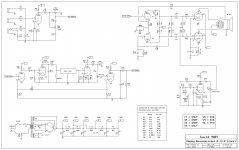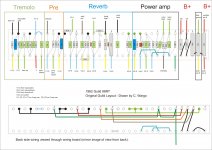hello,
i am going to start building this amp. i have search every where for a schematic that has the cap voltage rating and cant find one.
the amp is a ampeg r12r /guild rt98.
if some could maybe highlight the caps in different color codes or some thing and let me know the voltage ratings that would be awesome.
i.e.... all the ones marked in red have to be at least 600v......... the yellow have to be 50v.... etc etc i would be real grateful. its the easy way i can think to do it.
i'm guessing all the resistors will be 1/2 watt except for the ones that have ratings already beside them? thanks
i am going to start building this amp. i have search every where for a schematic that has the cap voltage rating and cant find one.
the amp is a ampeg r12r /guild rt98.
if some could maybe highlight the caps in different color codes or some thing and let me know the voltage ratings that would be awesome.
i.e.... all the ones marked in red have to be at least 600v......... the yellow have to be 50v.... etc etc i would be real grateful. its the easy way i can think to do it.
i'm guessing all the resistors will be 1/2 watt except for the ones that have ratings already beside them? thanks
Attachments
The plate caps, pins 2 & 5 of the 6sn7, have to be 400 v rated. See the power supply voltages lower left.
The power supply chain on the cathode of the rectifier, lower left, the first one has to be 400 v rated. The others could be lower as shown but you don't save any money by buying lower voltage, as the manufacturers did.
I'm not going to sweat through the tag board layout to figure out which cap is which. Look at the schematic.
The cathode circuit caps can be 100v or probably even 50.
I don't know ampeg, but looks like a pretty standard tube amp, with an extra reverb circuit. Get an ampeg impedence reverb tank, ie british, not a hammond organ origin tank. If you buy from a guitar parts shop you should be okay, but ask them if it is ampeg compatible if you talk over the phone.
Read some threads about return current (ground) techniques, there are a lot of ways to do it wrong and end up with a lot of hum. Running everything to chassis is the wrong way. Input grounds and speaker grounds should be separated except for a single tie point.
Best of luck.
The power supply chain on the cathode of the rectifier, lower left, the first one has to be 400 v rated. The others could be lower as shown but you don't save any money by buying lower voltage, as the manufacturers did.
I'm not going to sweat through the tag board layout to figure out which cap is which. Look at the schematic.
The cathode circuit caps can be 100v or probably even 50.
I don't know ampeg, but looks like a pretty standard tube amp, with an extra reverb circuit. Get an ampeg impedence reverb tank, ie british, not a hammond organ origin tank. If you buy from a guitar parts shop you should be okay, but ask them if it is ampeg compatible if you talk over the phone.
Read some threads about return current (ground) techniques, there are a lot of ways to do it wrong and end up with a lot of hum. Running everything to chassis is the wrong way. Input grounds and speaker grounds should be separated except for a single tie point.
Best of luck.
The cathode circuit caps can be 100v or probably even 50.
Even 450V ratings for all of the power supply caps would be fine.
I'd use a 100V cap for the cathode circuit of the output tubes.
Last edited:
I'm not going to sweat through the tag board layout to figure out which cap is which. Look at the schematic.
The cathode circuit caps can be 100v or probably even 50.
Best of luck.
thanks, i have the schematic posted. the tagboard is really just there in case someone reads this post in the future and decides to build one. it took me a while to find it.
thanks i have read up on grounding, it was mainly the coupling caps i weren't sure about because some amps use 600v and others use 400v.
i have every thing else pretty much sorted thanks.
this page has reverb tank listings Reverb Tanks
thanks, so in a basic amp like this its only the cathode caps i can get away with using lower rated caps for.Even 450V ratings for all of the power supply caps would be fine.
I'd use a 100V cap for the cathode circuit of the output tubes.
thanks, so in a basic amp like this its only the cathode caps i can get away with using lower rated caps for.
Yes, I'd use 35V caps for most of them, but use 100V capacitors for the output tubes' cathode circuit
to be safe there. Coupling caps should be rated similarly to the B+ caps.
for psu caps, i select them so that even without all the tubes in sockets,
they can still survive a power turn on....
they can still survive a power turn on....
for psu caps, i select them so that even without all the tubes in sockets,
they can still survive a power turn on....
Exactly, cascading failures are no fun.
I just leave the tubes in the sockets.
From reputable distributors, 400 V caps with >2000 hours life rating can be had for <$3. 450 v is more like $12 per section and no life rating (tall cans) or 1000 hours rating (vishay axials).
I've put 400 v ones in 525 rated spots (dynaco),or 450 v spots (hammond organ) and am going on 4 years trouble free service. With the tubes in place.
I try to limit e-cap purchases to panasonic, nichicon, rubicon, vishay, united chemicon, multicomp, CDE. In that order. CDE & United have a *****ier end of life test spec than the first three. I have some CE & FP tall cans, 6 years old and running fine, but not a lot of hours on them.
From reputable distributors, 400 V caps with >2000 hours life rating can be had for <$3. 450 v is more like $12 per section and no life rating (tall cans) or 1000 hours rating (vishay axials).
I've put 400 v ones in 525 rated spots (dynaco),or 450 v spots (hammond organ) and am going on 4 years trouble free service. With the tubes in place.
I try to limit e-cap purchases to panasonic, nichicon, rubicon, vishay, united chemicon, multicomp, CDE. In that order. CDE & United have a *****ier end of life test spec than the first three. I have some CE & FP tall cans, 6 years old and running fine, but not a lot of hours on them.
Last edited:
Even with tubes removed, the voltage in this comes nowhere near 600v. On a 450v cap, that 450v is a working volts rating. Caps also have surge ratings, so a 450v cap might have a 525v surge rating. This covers power up inrush.
Some old amps, from the era when caps were not cheap, I used to regularly see cathode bypass caps in preamp with 6v ratings. Certainly 25 or 35v is sufficient there.
Won't hurt to have 100v caps on the power tube cathode, but with a 250 ohm resistor there, about 400ma would have to flow through it. I doubt the power supply could supply that, but would load WAY down. That 100v has to come from somewhere. A zillion amps with a 25v cap there have worked for 50 years and more.
Some old amps, from the era when caps were not cheap, I used to regularly see cathode bypass caps in preamp with 6v ratings. Certainly 25 or 35v is sufficient there.
Won't hurt to have 100v caps on the power tube cathode, but with a 250 ohm resistor there, about 400ma would have to flow through it. I doubt the power supply could supply that, but would load WAY down. That 100v has to come from somewhere. A zillion amps with a 25v cap there have worked for 50 years and more.
over volting the psu caps is scary, i am now repairing an Antique Sound Lab 845 set
that had blown filter caps, raw ac at 780 volts is 1200 vdc at turn on when
filaments are still cold, so that two 450 volt caps in series do not stand a chance at long life...
in this case, i introduced external resistors about 200 ohms in series with the winding's
90 ohm dc resistance, this is not much but can help....
so i would rather err on the side of working the caps at 80% of their dc ratings
if only for my peace of mind....
this is just me though, you are free do do as you wish....
that had blown filter caps, raw ac at 780 volts is 1200 vdc at turn on when
filaments are still cold, so that two 450 volt caps in series do not stand a chance at long life...
in this case, i introduced external resistors about 200 ohms in series with the winding's
90 ohm dc resistance, this is not much but can help....
so i would rather err on the side of working the caps at 80% of their dc ratings
if only for my peace of mind....
this is just me though, you are free do do as you wish....
I just leave the tubes in the sockets.
From reputable distributors, 400 V caps with >2000 hours life rating can be had for <$3. 450 v is more like $12 per section and no life rating (tall cans) or 1000 hours rating (vishay axials).
I've put 400 v ones in 525 rated spots (dynaco),or 450 v spots (hammond organ) and am going on 4 years trouble free service. With the tubes in place.
I try to limit e-cap purchases to panasonic, nichicon, rubicon, vishay, united chemicon, multicomp, CDE. In that order. CDE & United have a *****ier end of life test spec than the first three. I have some CE & FP tall cans, 6 years old and running fine, but not a lot of hours on them.
where us the like button?😀
- Status
- Not open for further replies.
- Home
- Live Sound
- Instruments and Amps
- tube amp capacitor voltage ratings help please

